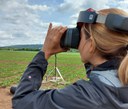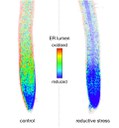News from INRES


Prof. Dr. Dennis Lehmkuhl from the Institute of Philosophy and Prof. Dr. Annaliese Mason from the Institute of Crop Sciences and Resource Conservation at the University of Bonn.

The drier the region, the fewer seminal roots the maize varieties cultivated there had on average (black figure; the pie chart shows the proportion of varieties with up to one seminal root in yellow, with up to three seminal roots in green and with more than three seminal roots in blue).

Head of INRES - Crop Functional Genomics at the University of Bonn.

Head of INRES - Root Functional Biology at the University of Bonn.

In the two plants on the right, a gene has been switched off with the effect that fewer seminal roots and more lateral roots grow. They recovered significantly better following a period of drought that the plant with the intact gene (plant on the left).


Samples the size of a brick were taken from the soil at different depths and the roots were then isolated, scanned and measured.




Agricultural scientist Prof. Anne-Katrin Mahlein is a pioneer in the field of sensing and imaging plant diseases.



